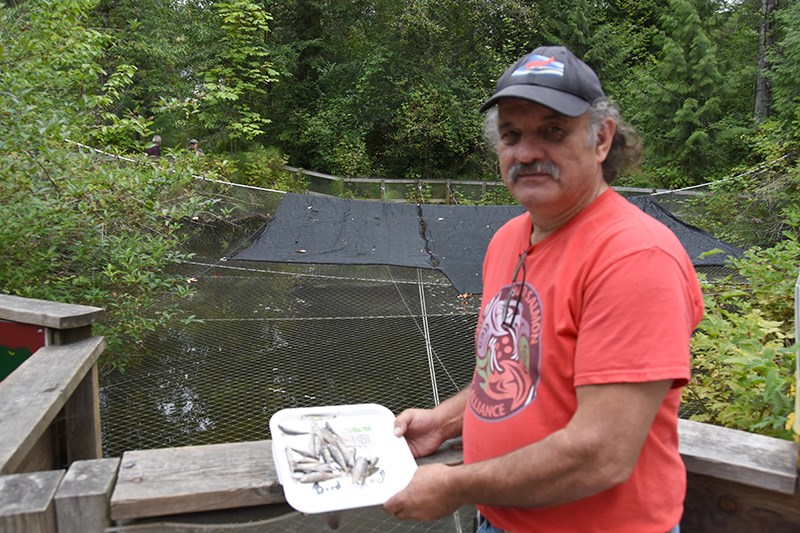Although Noons Creek Hatchery has been plucking almost 30 dead fish from the water daily during the last two weeks volunteers aren’t pushing the panic button.
In late July, they began noticing dead coho in the water. Earlier this month it began to range between 20 and 30 a day although on Tuesday (Aug. 6) it spiked to 152 before receding the next day.
Pinpointing the cause of death is as elusive as trying to catch a 40-pound salmon using only your hands.
The logical source, said Port Moody Ecological Society vice-president Dave Bennie, is contaminated storm sewer water flowing into the creeks. Chemicals from weed killers, soap scum from residents washing their cars, hot tubs being emptied or residue from backyard mechanics working on their vehicles are just some of the possible culprits. On top of all that, the mortality rate rises with the temperature of the water, especially if it’s more than 16C. This past week it was in the 19C range.
“That’s pretty warm for salmon,” said Bennie, who pointed out the cause could be something more natural.
“When they’re dying a lot of the other fish go up and they mouth them, so if there’s a virus or something they could be spreading it just like us. They always pick on the dead ones.”
Narrowing it down to a specific offender is difficult and expensive said Bennie and hatchery manager Doug Calder. Although the hatchery has in the past sent samples to be tested at a lab based at Departure Bay in Nanaimo, it costs about $100 to test each specific chemical or mineral and with so many possibilities it’s an expensive proposition.
“They want to know what parameters they’re looking for, but you don’t have a clue what it is,” said Bennie, who found 38 dead fish Friday.
Added Calder, “When you’re losing 20 or 30 here or there that’s pretty much business as usual. When you start to lose about 1% per day, which in our case would be about 130 a day or so, that’s when you start to get the attention of the DFO [federal department of fisheries and oceans]. Then they’ll start stepping in.
“We’re in a little bit of a situation but nobody’s terribly panicking, but it’s got our attention for sure. We do want it to get it back down to just a couple of day if we can.”
The first plan of attack, said Calder, is to try and flush out the contaminants by opening up a four-inch pipe upstream at the Cypress Lake dam that can pump 15 to 20 litres of water per second into the system which they were about to do Friday afternoon.
“It will raise the oxygen [level] and lower the temperature,” said Calder, who like Bennie. “The dam gives about two months supply of fresh water so we have to be careful about opening it up too early. In mid-August, we probably don’t have to worry about running out of water up at the lake. So we can feel pretty comfortable about opening it up”
The rain forecasted for this weekend will help, too. In fact, ideally they’d like it if precipitation fell in the area periodically throughout the summer.
“If it would rain [once a] week during the summer that would be perfect for us,” said Calder. “Our creek dries up pretty quick. About every seven days if you get a good flush that’s good.”
A few years ago, said Port Moody Ecological Society lifetime member Eric Olsen, the death toll hit an average of 130 a day. That prompted the DFI to add antibiotic food into the water.
“It was so sudden and great it motivated the powers to be to do something of a remedial manner,” said Olsen. “If it gets to a high mortality rate they will do something.
“There was no evidence [the antibiotic food] was the solution, because there was no evidence of a sudden stopping of the death rate, it just tapered off.”
Olsen emphasized that despite the current situation there’s still a lot of positives about the operation because it has a stock of more than 12,000 fish in the system, and the object is to have 10,000.



